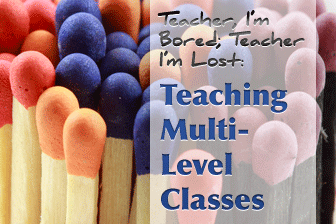Something for Everyone: Reaching Even Lowest Level of ESL in the Multi-Level ESL Classroom


And all ESL classes are multi-level, even those not officially designated as such: for example, one student may be strong in speaking skills while another strong in reading. A concern with teaching the multi-level class is holding everyone’s interest and meeting everyone’s needs, no matter their level. A variety of students study in a multi-level class: students who are just learning to speak English, students who are fluent but want to work on their pronunciation, as well as students who have conversational English but need to work on academic skills.
How do you meet all of these varied needs?

Start with a needs assessment. Find out what students want to learn and are interested in. If most in a class are career-oriented, for example, focus on the vocabulary needed for career success. For example, academic English vocabulary is full of Latin root words such as “obese” that are different from the more Anglo-Saxon roots of conversational English, such as “fat.” It is this vocabulary students need to succeed in college classes for later professional success.
In addition, do a skills assessment the first day and find out what students’ levels are by an informal interview, asking students about their background and then taping it. Also do a writing assessment on a simple topic like “A Life Lesson.” Then make decisions about grouping from this assessment. Sometimes it makes sense to group students of similar ability levels, such as when doing a listening comprehension task; other times, however, such as when engaged in discussion, students can be grouped across levels.
Choose themes. Find out what themes students are interested in by polling them and showing visuals: sciences, education, art, and so forth. Build your class around these themes, with easier materials for the lower levels and harder for the higher levels. Usually one week of focus on a theme is sufficient.
Plan carefully for the multilevel class. This is crucial, to have enough activities for each of the levels, or flexible activities, with different material for students at different levels of English acquisition. So while a beginning student could be working on vocabulary related to college life, for example, a more advanced student could be writing a paragraph or essay on the same topic.
Use the whole-class-to-leveled groups approach. In larger classes, you may group students by level or in heterogeneous groups while in smaller classes you can split your time effectively between individual students. Start an activity by discussing it in general with the class as a whole: the topic of family, for example. Allow students to offer comments as they wish at the beginning then break into leveled groups for learning vocabulary words related to family, for example, for lower levels; higher levels can do a more advanced reading on the topic.
Include a variety of modalities and strategies: use visuals, stories, and movies. These are amazing tools in a multi-level class because a variety of students at different levels will relate to and gain something from them. Showing a movie, for example, provides opportunity for a variety of activities. If the movie can be show with closed caption, in English, this helps students’ reading skills. Higher level students can write critiques and engage in discussions after about the movies; lower level students can focus more on short oral and written summaries.
Include also a variety of activities for different language skills within a class. This is a way to meet the needs of all students, from the student who needs work on basic literacy to the student who wants to work on more advanced pronunciation and accent reduction.
Referring back to your themes list, you may start out with an activity such as a visual that all students will benefit from: a provocative picture from a recent news magazine, for example, or a picture of an abstract painting. Have students first discuss the visual as a whole class, and then the higher level students may write their interpretation of the visual while the instructor can help the lower level students with vocabulary and grammar.
Language experience, in which students dictate a story related to the theme, and the teacher or another student writes it on the board, is also a useful approach involving a variety of skills and levels. Again, move from a broader topic and break it down by pronunciation, grammar, and vocabulary. This also presents an opportunity for teachers to mix up groupings, from heterogeneous to level based to skilled based.
Projects are a great way for students to all students to be able to participate at a level that is comfortable yet also challenges them. For example, in the project of setting up a class website, the student with excellent literacy and computer skills may find himself in a leadership role that challenges him to use his speaking skills more, skills he is not so sure of. The students who are just learning English may also participate by posting their profiles to the site. Projects are a good way for everyone to participate, develop English skills, and make friends.
A multilevel class provides a great opportunity for peer tutoring, where students work in pairs, with one tutoring the other. Students with strong reading skills could be matched with students strong in speaking skills, and they could assist each other.
Finally, drama is an activity that all students in a multi-level classroom can benefit from. In completing the class project of a short play, the upper level students can write the scripts, and the lower-level students can participate in minor roles while students with stronger speaking skills can take the major roles.
Instructors have to be flexible to accommodate not only different levels of English learning but also different language skills and instructional methods. With flexibility, however, teaching the multilevel class can be very rewarding.